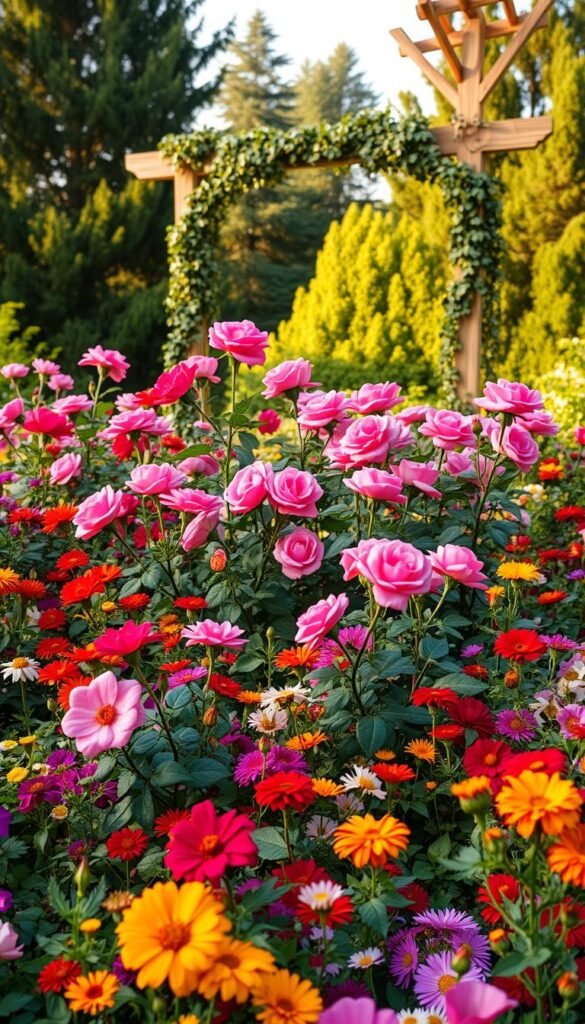Roses might get called “divas” of the plant world, but they’re surprisingly good team players. When paired with the right neighbors, these classic bloomers create eye-catching displays while improving your garden’s health. The secret lies in choosing plants that complement their elegance and address their needs.
Smart companion planting does more than add beauty. Certain species help deter pests naturally, while others attract pollinators that benefit your entire landscape. You’ll find options that fill gaps between bloom cycles, keeping your space vibrant even when roses take a breather.
The best combinations balance form and function. Tall perennials add vertical interest behind bushier varieties, while low-growing annuals create living mulch. Contrasting leaf shapes make both plants stand out, and strategic color pairings can make petals pop.
This approach transforms single-note beds into layered masterpieces. You’ll enjoy continuous color from spring through fall while giving your roses the supportive cast they deserve. With thoughtful planning, your outdoor space becomes a dynamic showcase of textures, hues, and seasonal drama.
Identifying Ideal Companion Plants for Your Rose Garden
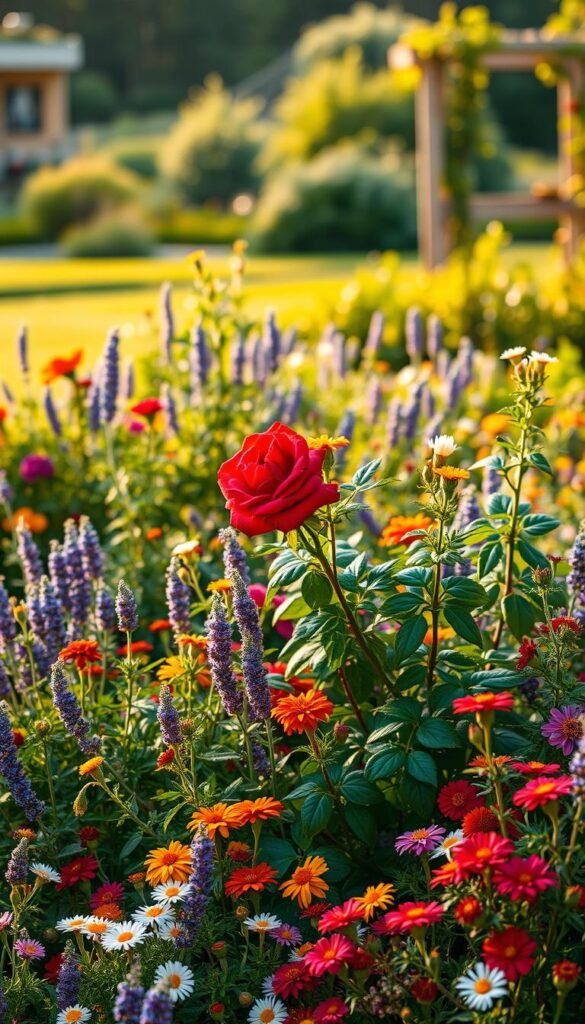
Selecting the right companions for roses boosts both beauty and garden health. Start by matching their sunlight and water needs—most roses thrive with 6+ hours of sun and well-draining soil. Plants that demand less moisture or prefer shade will struggle alongside these sun-loving bloomers.
Benefits of Companion Planting
Strategic pairings create a give-and-take relationship. Fragrant herbs like lavender naturally repel aphids, while marigolds deter nematodes in the soil. Tall perennials such as delphiniums draw pollinators upward, ensuring roses get visited too.
Choosing Compatible Annuals, Perennials, and Shrubs
Focus on plants that enhance without overpowering. Soft silver foliage from artemisia makes crimson roses pop, while compact salvia adds vertical accents. For structure, boxwood shrubs frame beds neatly.
| Plant Type | Key Benefits | Top Picks |
|---|---|---|
| Annuals | Season-long color, pest control | Marigolds, petunias |
| Perennials | Year-round structure, pollinator support | Catmint, yarrow |
| Shrubs | Wind protection, visual anchoring | Spirea, hydrangea |
Remember: Diversity strengthens your garden’s ecosystem. Mix plants with different bloom times and heights for continuous interest. This approach keeps pests confused and beneficial insects engaged all season.
Understanding the Needs of Shrub Roses
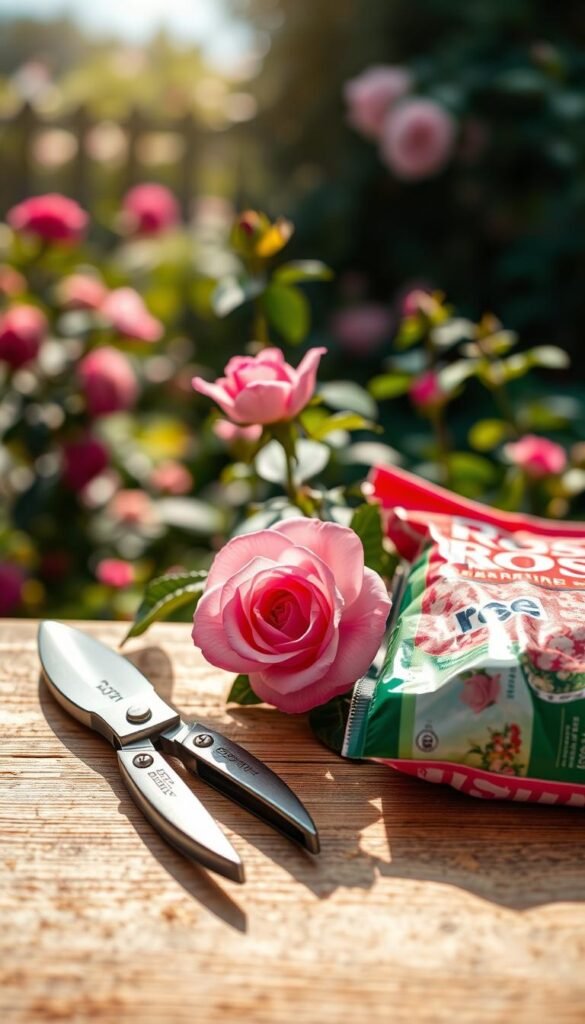
Thriving shrub roses start with mastering their fundamental growing conditions. These robust beauties demand specific care to unlock their full potential, but the effort pays off in breathtaking blooms and vigorous growth.
Water, Soil, and Sun Exposure Essentials
Your shrub roses need at least six hours of direct sunlight daily. Without this full sun exposure, they’ll produce fewer flowers and become more prone to disease. Pair them with companions that share this light requirement for a harmonious bed.
Well-draining soil makes all the difference. While roses love moisture, their roots suffocate in soggy conditions. Test your soil’s drainage by digging a 12-inch hole—if water remains after an hour, amend it with compost or sand.
These plants thrive in slightly acidic to neutral soil (pH 6.0–7.0). This range suits many low-maintenance flowers too, simplifying companion planting. Enrich the earth with organic matter before planting roses to boost fertility.
Water deeply but infrequently to encourage strong root systems. Aim for 1-2 inches weekly, adjusting during heatwaves. Mulch around the base to retain moisture and prevent soil splashing onto leaves—a common cause of fungal issues.
Good air circulation prevents mildew and black spot. Space plants properly and avoid overcrowding. Shelter them from harsh winds with strategic placements like fences or sturdy perennials, but never sacrifice sunlight for protection.
How to Combine a Rose Flower Garden with Annuals and Perennials
Transform your rose beds into living tapestries by layering temporary and permanent bloomers. Annuals bring instant impact with their non-stop color, while perennials offer reliable structure season after season.
Annual Stars for Continuous Color
Sweet alyssum forms fragrant carpets beneath taller varieties, its tiny blossoms softening bed edges. Angelonia’s spire-like flowers rise between bushes, maintaining visual interest when roses pause blooming. Trailing calibrachoa spills from containers with confetti-like blooms, perfect for filling awkward gaps.
Perennial Performers for Lasting Beauty
Catmint’s lavender-blue spikes contrast beautifully with pink and red varieties, while its aromatic foliage deters pests. For silver accents, try artemisia’s feathery leaves against deep crimson blossoms. Proven companions like salvia offer vertical punctuation in mixed borders.
| Plant Type | Seasonal Impact | Design Role |
|---|---|---|
| Sweet Alyssum | Spring to frost | Groundcover |
| Angelonia | Summer peaks | Vertical accent |
| Catmint | Repeat blooms | Pollinator magnet |
| Russian Sage | Late summer | Airy texture |
Pro tip: Match bloom cycles for nonstop drama. Pair early-flowering perennials with late-season annuals to maintain momentum after rose petals fade. Contrast leaf shapes make both plants pop – try broad rose foliage against fine-textured partners.
Enhancing Your Garden with Foliage and Texture
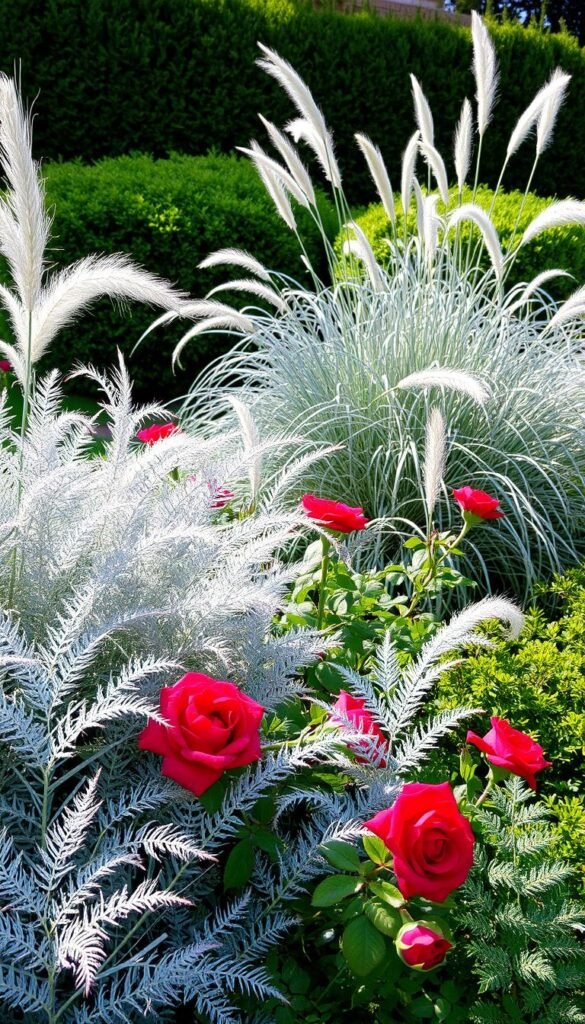
Foliage acts like nature’s stage lighting, intensifying your roses’ performance while adding depth to garden designs. Strategic use of leaf shapes and colors creates year-round interest, even when blooms take center stage.
Silvery Accents Meet Airy Textures
Artemisia’s feathery silver leaves make red and pink varieties glow like neon signs. This drought-tolerant perennial thrives where other plants struggle, forming elegant mounds that frame beds without stealing attention. Lamb’s ear offers velvety texture near pathways, its soft leaves contrasting with rose thorns.
Ornamental grasses like blue fescue bring movement to static layouts. Their wispy blades dance in breezes, creating dynamic backdrops for sturdy rose bushes. Pairing bold green foliage with delicate grass textures adds sophistication to any design.
For low-maintenance drama, try these combinations:
- Silver mound artemisia + coral drift roses
- Blue oat grass + white iceberg varieties
- Lamb’s ear + deep purple hybrid teas
These pairings work because they balance visual weight. Heavy rose shrubs gain lightness from airy partners, while silvery tones make flower colors pop. Your garden becomes a textured tapestry that holds interest long after petals drop.
Season-by-Season Planting Guide
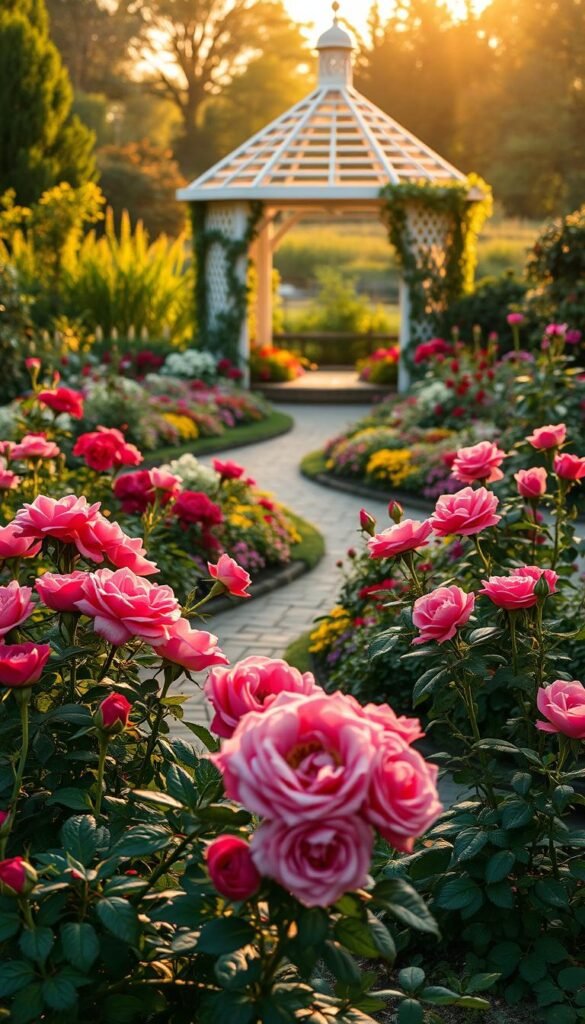
Timing becomes your secret weapon for nonstop garden drama. By coordinating bloom cycles, you create seamless transitions between seasons while letting roses shine during their prime.
Spring and Early Summer Strategies
Winter’s end brings opportunities. Evergreen pulmonarias brighten bare beds with speckled leaves, while snowdrops push through frost. These early risers give structure before roses wake from dormancy.
As temperatures rise, late spring performers take over. Tulips mirror rosebud colors, creating harmonious previews. Aquilegia’s nodding flowers bridge the gap until main bloom cycles begin. Plant these companions 6-8 weeks before last frost for synchronized displays.
Late Summer to Fall Planting Tips
When summer heat peaks, salvias and verbenas keep the show alive. Their drought tolerance complements roses needing less water. Compact dahlias add fiery hues as nights cool, extending color until first frost.
Prepare autumn’s cast in midsummer. Sedums develop rich burgundy tones that contrast fading petals. Ornamental grasses gain height, providing winter interest after plants go dormant. This layered approach ensures every season tells its own story.
Tips for Spacing and Designing Mixed Borders
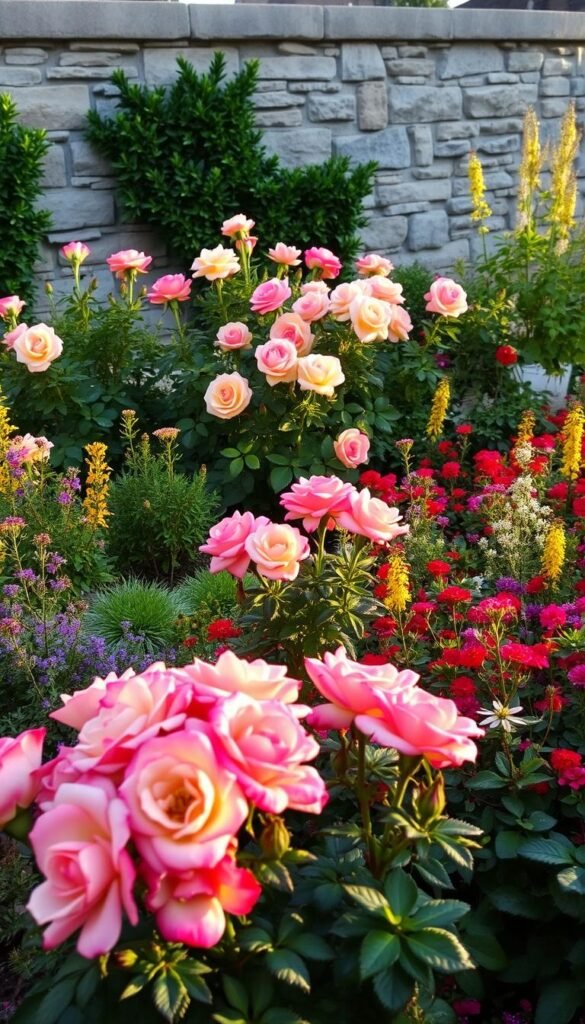
Smart spacing forms the backbone of every thriving garden design. Imagine your border as a living puzzle where each piece needs room to grow into its best shape. This approach prevents overcrowding and lets each plant showcase its unique features.
Planning for Mature Plant Size
Always check plant tags for final dimensions. A shrub that grows 3 feet wide needs 3 feet of space on all sides. That boxwood specimen might look lonely at planting time, but it’ll fill its designated area beautifully in two seasons.
Create depth by layering plants like theater seating. Place tall varieties like delphiniums or hollyhocks at the back, medium-height roses in the middle, and compact annuals like lobelia up front. This arrangement ensures every plant gets its moment in the sun.
Resist filling gaps with permanent plants. Instead, use quick-growing container garden favorites as temporary placeholders. Petunias or marigolds add instant color while slower-growing perennials establish themselves.
Remember these spacing essentials:
- Measure twice, plant once – account for mature widths
- Leave breathing room between foliage layers
- Adjust placements based on sunlight patterns
Pro tip: Use garden stakes to mark future growth areas when planting young specimens. This visual guide helps prevent accidental overcrowding as your border matures.
Boosting Pest Control with Companion Choices
Your roses deserve bodyguards that work around the clock without chemicals. Strategic plant partnerships create natural defense systems while enhancing your garden’s beauty. These allies tackle pests through scent warfare, predator recruitment, and clever camouflage tactics.
Nature’s Pest Control Squad
Catmint serves as triple-threat protection. Its aromatic leaves repel aphids while inviting pollinators and predatory insects. Plant it near roses for a fragrant security system that blooms all summer.
Alliums offer underground and aerial defense. Their pungent smell masks your roses’ scent from pests, while globe-shaped flowers attract hoverflies. These beneficial insects devour soft-bodied pests like mites.
| Plant | Pest Control Superpower | Key Features |
|---|---|---|
| Catmint | Repels aphids, attracts bees | Drought-tolerant, reblooming |
| Alliums | Confuses Japanese beetles | Deer-resistant, structural interest |
| Marigolds | Deters nematodes | Edible flowers, rabbit-proof |
| Bee Balm | Lures predatory wasps | Native species, vibrant colors |
Marigolds work overtime beneath the soil surface. Their roots release compounds that repel harmful nematodes, while bright blooms draw ladybugs. These spotted hunters eliminate up to 50 aphids daily.
For comprehensive protection, mix these proven companions throughout your beds. Their combined scents create an olfactory maze that confuses pests searching for your prized blooms.
Designing with Color and Height Variation
Mastering color and elevation transforms flat beds into living landscapes. Your border becomes a dynamic canvas where hues dance and textures whisper. The magic happens when you balance these elements to guide the eye and stir emotions.
Blending Complementary Colors and Textures
Vibrant combinations energize spaces. Purple salvias electrify yellow varieties, while crimson blooms glow against silver foliage. For serene elegance, pair white roses with blue-toned partners like nepeta.
Foliage offers year-round texture play. Velvety lamb’s ear leaves contrast with glossy rose foliage, creating tactile interest. Mix feathery ferns with bold hosta leaves to amplify visual drama.
Creating Visual Depth with Varied Plant Heights
Layer plants like a cascading waterfall. Place towering foxgloves behind mid-height floribundas, then let thyme spill over edges. This arrangement tricks the eye into seeing expanded space.
| Planting Zone | Height Range | Suggested Plants |
|---|---|---|
| Back Border | 4-6 ft | Shrub roses, hollyhocks |
| Mid Border | 2-3 ft | Peonies, salvias |
| Front Edge | 6-12 in | Thyme, alyssum |
Pro tip: Use vertical accents sparingly. One delphinium spike per 3 feet creates rhythm without clutter. These “exclamation points” draw attention to your finest blooms.
Incorporating Companion Planting in Containers and Small Spaces
Limited space becomes an opportunity for creative partnerships between roses and their botanical allies. Compact arrangements let you enjoy vibrant combinations on patios, balconies, or narrow beds. The trick lies in selecting plants that enhance without overcrowding.
Space-Smart Plant Partners
Dwarf lavender thrives alongside roses in pots, offering pest-repelling fragrance and vertical contrast. Miniature marigolds nestle at container edges, their golden blooms deterring pests while brightening tight spaces. For trailing elegance, bacopa spills over planter rims with delicate white flowers.
Multi-functional choices work best in confined areas. Herbs like thyme serve triple duty—they’re edible, aromatic, and suppress weeds. Pair them with petite rose varieties that max out at 2 feet tall. This approach ensures every plant earns its spot through beauty and utility.
Rotate seasonal annuals to maintain freshness. Spring pansies give way to summer lobelias, then autumn ornamental kale. Your small-scale display stays dynamic while supporting rose health year-round. Even tiny gardens can host thriving ecosystems when companions play their roles well.

